Contents
- rabbit keeping in the flat
- No rabbit wants to live in a cage!
- Keeping in the house appropriate to the species
- Rabbit enclosure, rabbit room or free housing?
- Exercise, Freewheel & Employment
- „Location“
- Size and minimum dimensions
- Building rabbit enclosures
- Making the apartment rabbit-proof
- Equipment & Accessories
- Toilets & housebreaking
- Hygiene & Odor
- Problems with keeping in the house
- Health disadvantages
rabbit keeping in the flat
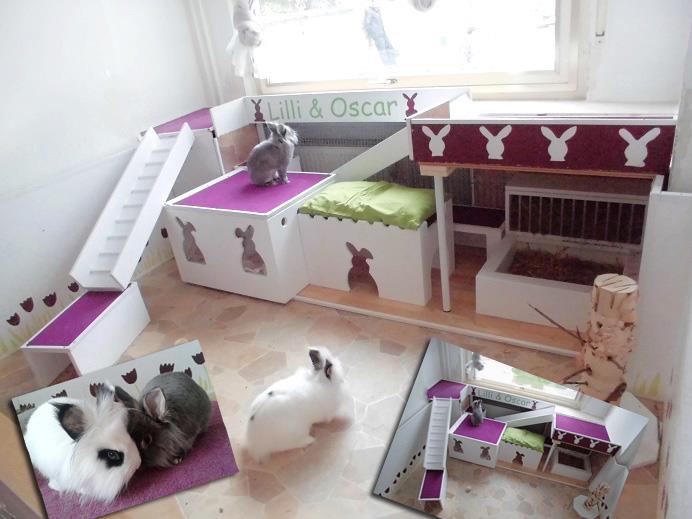
A rabbit keeping in the apartment generally presupposes the readiness to make compromises. Who decides for the keeping in the house should be ready for it to tolerate also some behaviors of the rabbits (e.g. the gnawing of chair legs or droppings on the carpet). Therefore, the house keeping enables the close contact to the animals and enriches the everyday life.
> Posture example photos for house keeping
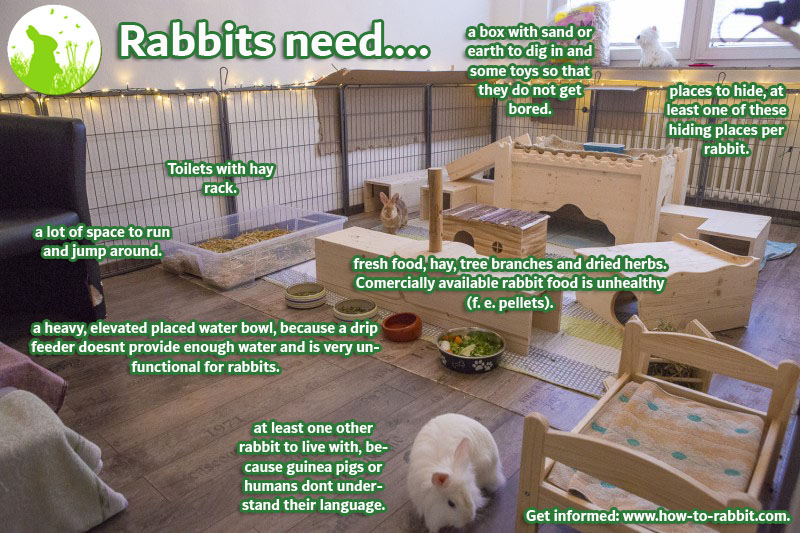
No rabbit wants to live in a cage!
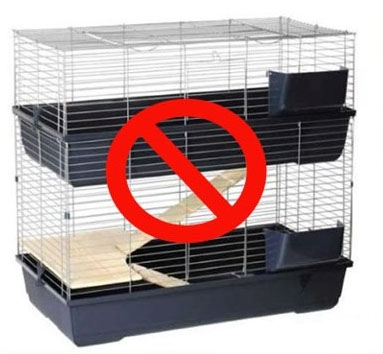
Even if still many rabbits have to live in cages – all commercially available cages are cruel to animals, even „very large cages“ are too small. No rabbit wants to be imprisoned in a small cage:
- Even in large cages the rabbits cannot move properly, they can neither run nor hook, dig, avoid other rabbits, chase each other or really accelerate.
- Often it comes to strong injuries or incompatibilities by the narrowness. Similar to when we are locked up with a good friend in a guest toilet, the lack of space often leads to aggressions with animals as well. The animals cannot evade or retreat.
- Rabbits are change-active, i.e. they do not sleep through at night (as we humans or many other animals do) but are also very active at night. Therefore, they need a lot of space day and night.
- Many rabbits develop behavioral disorders out of boredom and engage in undesirable activities, e.g. gnawing at the stable from the inside, nibbling at the grid, licking a spot in the fur or making stereotypical movements.
- The cage posture leads to spinal curvature and joint damage in the animals that enjoy movement. For example, the thigh bone structure is not completely formed and the permanent incorrect posture leads to pathological curvature of the spinal column. Digestive problems often occur due to lack of exercise.
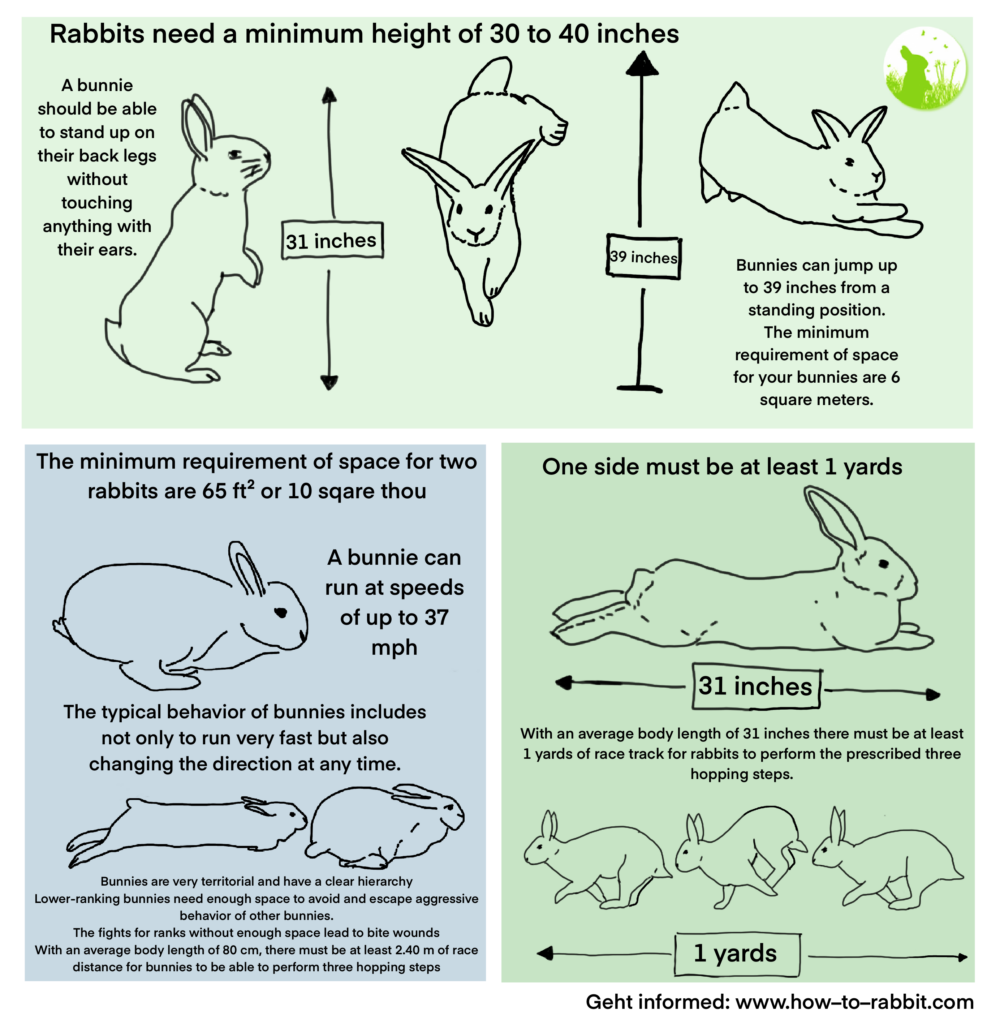
Keeping in the house appropriate to the species
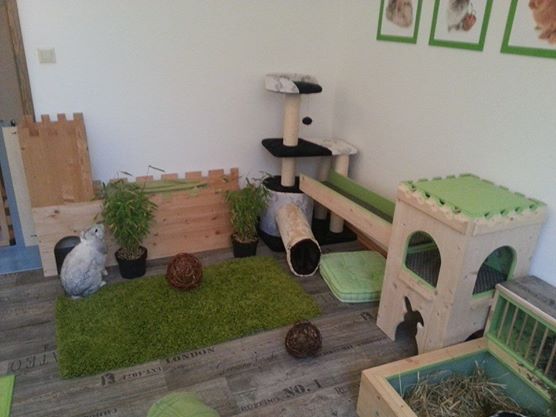
It is not a matter of „putting the rabbits away“, as it is often described in guidebooks. Rather, it is about living harmoniously together so that both sides are happy.
Rabbit enclosure, rabbit room or free housing?
It depends on the rabbit, the owner and the living situation which type of housing is most suitable.

A rabbit enclosure has the advantage that an area belongs entirely to the rabbits and can be designed accordingly. Straight rabbits which are not house-trained, very strongly the dwelling destroy or very much alone are usually held in a large enclosure. An enclosure can also offer protection from other pets (e.g. dogs).
Very popular are also rabbit rooms which are designed completely according to the needs of the rabbits (e.g. not heated). The advantage of this type of keeping is that the rabbits have a lot of space and also not house-clean or destructive animals can be kept. However, the keepers should stay much with their rabbits, otherwise the rabbits live too secluded and are bored. It would be even better if the door was always open and only a grid was attached. So the rabbits also get what happens outside the room.
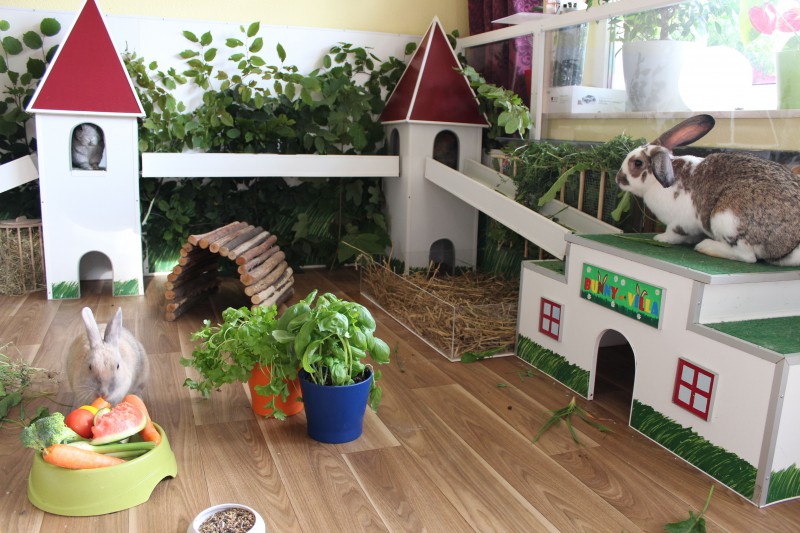
The free housing keeping (or also free room keeping) makes a close living together possible between the rabbits and their owners, the rabbits participate actively in the everyday life and occupy themselves by the procedures in the dwelling and the mechanism. Rabbit equipment can be set up usually discreetly in the dwelling. The rabbits have much place and the owner must sacrifice no extra range for the rabbits, which is meaningful straight in small dwellings. However, this attitude form is possible only if it is well planned and before the rooms are made rabbit-proof. In addition, the rabbits must be house-trained. For “destroyer-rabbits” this attitude is less suitable.
Exercise, Freewheel & Employment
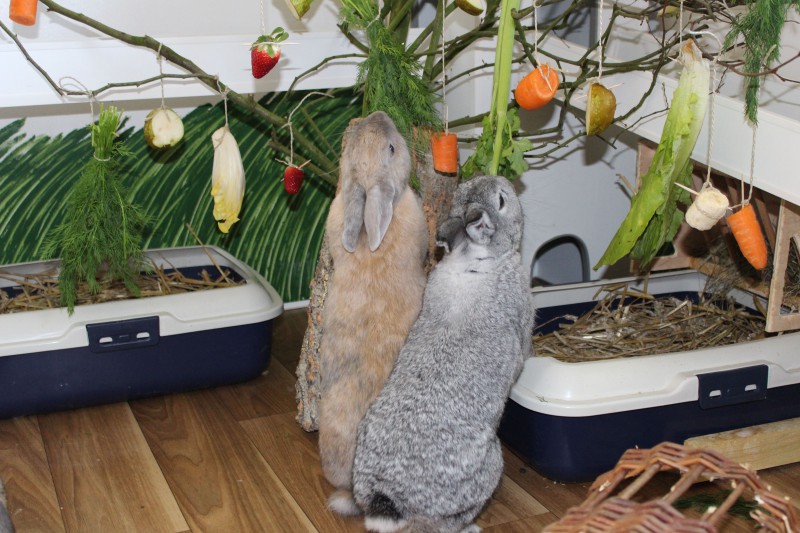
Rabbits are very curious and intelligent, they need variety and activity every day to be happy and balanced. Therefore, daily exercise or (e.g. in rabbit rooms with a lot of space) at least a period of employment is necessary.
Rabbits want to experience something, participate in the life of their owners and discover and explore new things. Put the time of departure into the activity times of your rabbits (usually early in the morning and late in the evening), so that they can use these also well. Supervise your rabbits if you are not sure whether an unattended free run will work. Eliminate sources of danger in the run-out area and protect your equipment. Train the housebreaking. The rooms should also be equipped with some rabbit toys, such as shelters, cat scratching trees, twigs, a bottle crate or tunnel. These furnishings can serve as employment if they are regularly exchanged and changed. If you have a balcony or garden, you can also allow the rabbits to run freely there. However, keep in mind that rabbits must never be locked outside in winter, as they must always be able to return to their usual temperature if there is a greater difference between inside and outside temperatures.
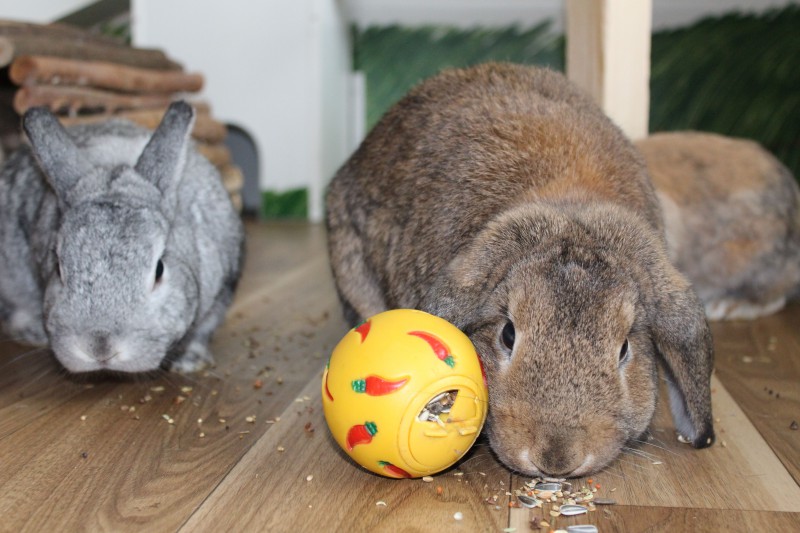
„Location“
Rabbits want to participate actively in life, to get to know what is happening around them. Therefore, they should be accommodated in a central room where they spend a lot of time (e.g. living room).
Size and minimum dimensions
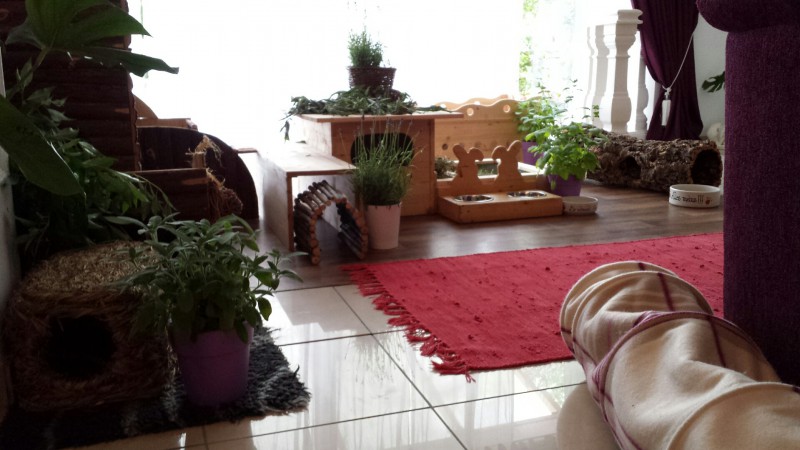
Rabbits need a lot of space to be able to move properly and not get bored. Also in the apartment they should have at least 65 ft² (US) or 10 sqare thou of unobstructed floor space (without floors) available day and night. In addition, with this size, daily exercise is absolutely necessary. If the rabbits should not get a daily run out, the rabbit enclosure must be clearly larger.
See: How much space do rabbits need?
Building rabbit enclosures
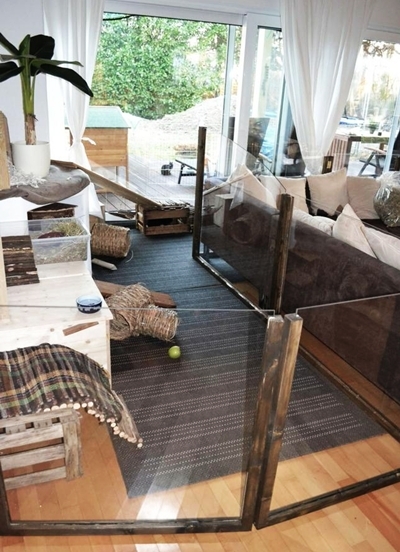
Rabbit areas are usually built simply and cheaply, if you know how to do it. The best way to create a border is to either set up a free-running enclosure grid (6- or 8-corner enclosures that can be extended at will, available in pet shops or cheaply on Ebay), use a puppy grid or make frames with wood and grid (or alternatively plexiglass/hobby glass) and join them together to form an enclosure. Buy in any case very high grids, because under 80cm each rabbit jumps over the border, easily. The lattice should be min. 1 m high if you have rabbits that like to jump. Sensitive floors can be underlaid with a cheap, non-slip PVC floor covering (not completely smooth!), which must be secured at the edges with PVC strips so that it is not gnawed.

On open sides it can be designed simply overlapping, then the rabbits also do not come to the edges. The PVC can be covered with small cotton carpets (so that they fit in the washing machine), which are comfortable and not as slippery as the PVC. These are washed as needed or about once a week. The area should be arranged rabbit-friendly. In the case of rabbits that are gnawing, it makes sense to protect the walls with grids, plexiglass or e.g. bamboo carpets. Here you will find further information and tips on construction.
Making the apartment rabbit-proof
How to make a room or the whole apartment rabbit-proof, so that your equipment is not damaged by the rabbits and all sources of danger for the long ears are eliminated, you learn here.
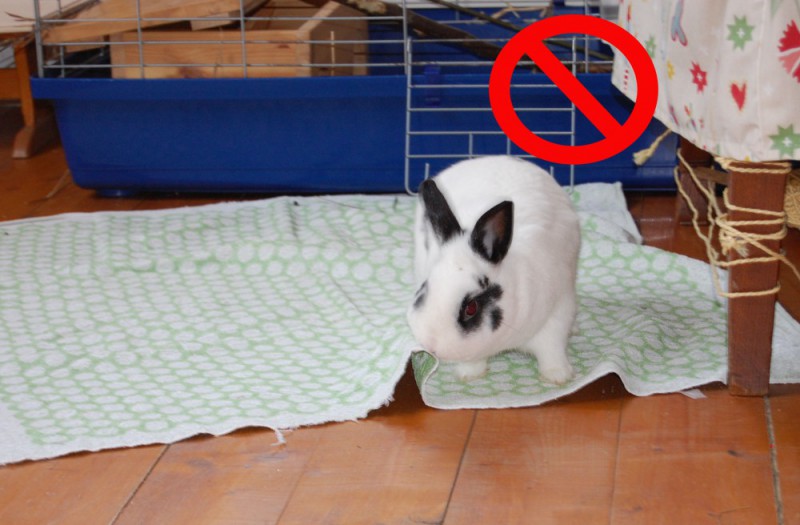
Important: For lattice cages that are positioned in such a way that the rabbits can jump on them, the upper part of the lattice must be covered with a carpet or wooden board so that the rabbits cannot injure themselves when jumping up. Or you can remove the top of the grate completely and just put up the tub. In addition, the grid door should be unhinged or covered (e.g. with a willow bridge) because there the rabbits can get caught with their feet while jumping, which can lead to serious injuries.

Equipment & Accessories
In addition to the basic accessories, the right equipment is also very important so that the rabbits feel comfortable and busy. Please note that there are also accessories that are contrary to animal welfare.
Toilets & housebreaking

Like cats, rabbits can be made housebroken. However, they can be educated more badly, rather the owner must adjust itself somewhat to the rabbits. The rabbits themselves choose their favorite pee corners, usually room corners or other edge areas are chosen. At these places cat toilets are set up. Droppings are also sometimes next to house-clean rabbits, so that it is necessary to hoover up daily. Offer large enough toilets in the corners and at the edges as well as at the feeding place. Protect sensitive floors in the enclosure and in rabbit areas with PVC flooring (which protects the edges from gnawing!) or linoleum.
Hygiene & Odor

Especially in the flat, hygiene is very important to avoid unwanted odors and a strain on the respiratory tract. It is best to use wood pellets with a layer of hay or straw on top or corn or wood granulate. These litter types bind the smell and the liquid, particularly well. Clean the toilets each one to two days and wash them out with warm water and vinegar essence or citric acid.
Problems with keeping in the house
Behavioral problems

There are frequent problems with the house-cleaning with apartment rabbits. Also in the case with cat and dog keeping, cleanliness education is a difficult subject that requires individual solutions.
The rabbit’s need for gnawing can also become a problem. Who keeps rabbits in the dwelling, must be clear itself that thereby damage to the mechanism can develop. Rabbits have a natural environment in which they can find gnawing material in the form of meadow plants, twigs, bark, roots, foliage, etc., all the time and everywhere. Use metal furniture and offer them in many places fresh branches, fresh fodder from nature, boxes of hay and straw, but also seasonal leaves, bark, roots and snow in boxes. Set up a really big crate in which you fill different material for digging. For example, sand or earth, or if the rabbits also use the box as a toilet, it is better to use different types of bedding.
In addition, keep your rabbits busy. In the apartment the rabbit lacks the environmental stimuli, so it can be that the animals are not busy and destroy the equipment, dig up the toilet or hunt each other. Often it is also to be observed that bored indoor rabbits with little activity nibble off or lick the fur of their partner rabbits or themselves, so that bald spots develop.
If possible, offer exercise on the balcony or in the garden. If it is cold outside, the door must remain open so that the animals can return to their usual temperature at any time. An alternative is the cat flap.
In extreme cases a very large enclosure must be separated from the room or a separate room must be available to the rabbits, which offers a habitat to the rabbits also without run. Some animals are never house-trained and should (if no place for a large enclosure is available) in outside attitude be obtained. Cage keeping is no solution! Who would lock his cat in a cage because it is not housebroken or scratched the armchair?
Health disadvantages
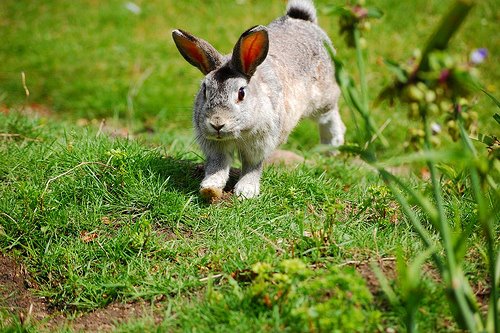
Make sure you have enough fresh air and light, rabbits need fresh air and enough daylight. The window glass absorbs UVB rays. This causes vitamin D deficiency. Find out how you can prevent this. Air polluted with ammonia, dust or other substances as well as heating air, pollutes the immune system and the respiratory tract, so regular ventilation is an absolute must. In addition, care should be taken to ensure a healthy indoor climate and low-dust bedding. Of course, rabbits with their sensitive airways should never be exposed to cigarette smoke.
Many indoor rabbits also have problems with digestion, this is because some indoor keepers feed their animals only very carefully, over-cautiously and unnaturally. Also indoors rabbits need various branches (fresh weekly!), several hay mountains in different places and daily fresh green fodder, best from nature, so meadow herbs, grasses, tree leaves… In addition, indoor rabbits often have a slowed metabolism and eat unnatural things such as carpet fibers, paint of painted furniture and plastic. Many rabbits also move much less indoors due to a lack of environmental stimuli.
